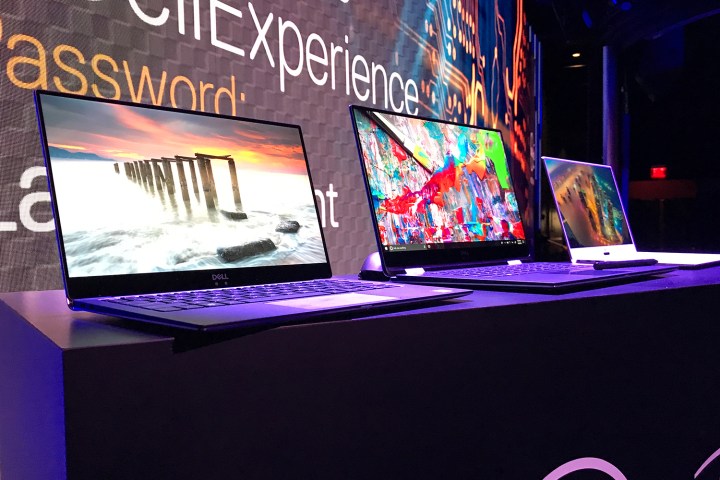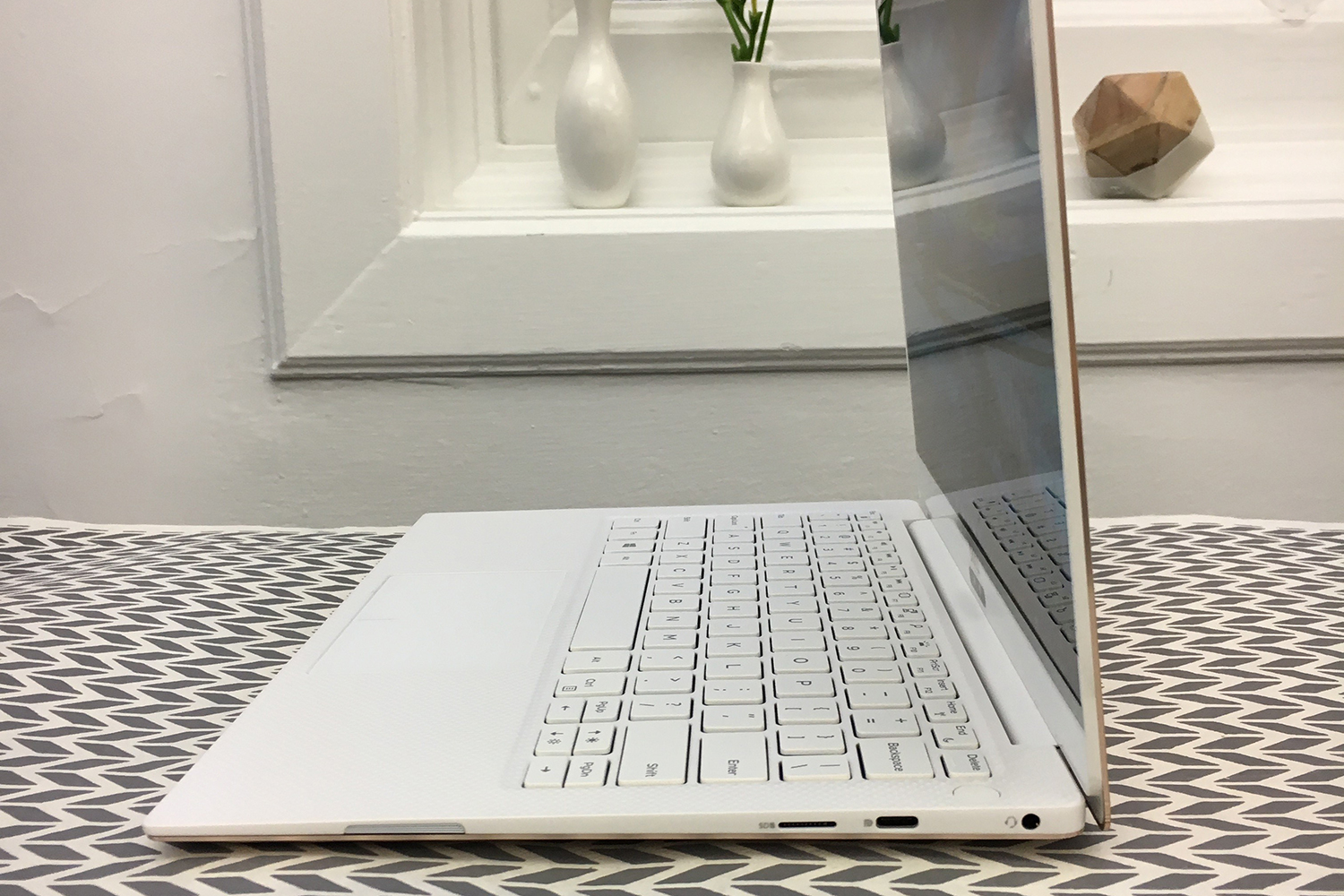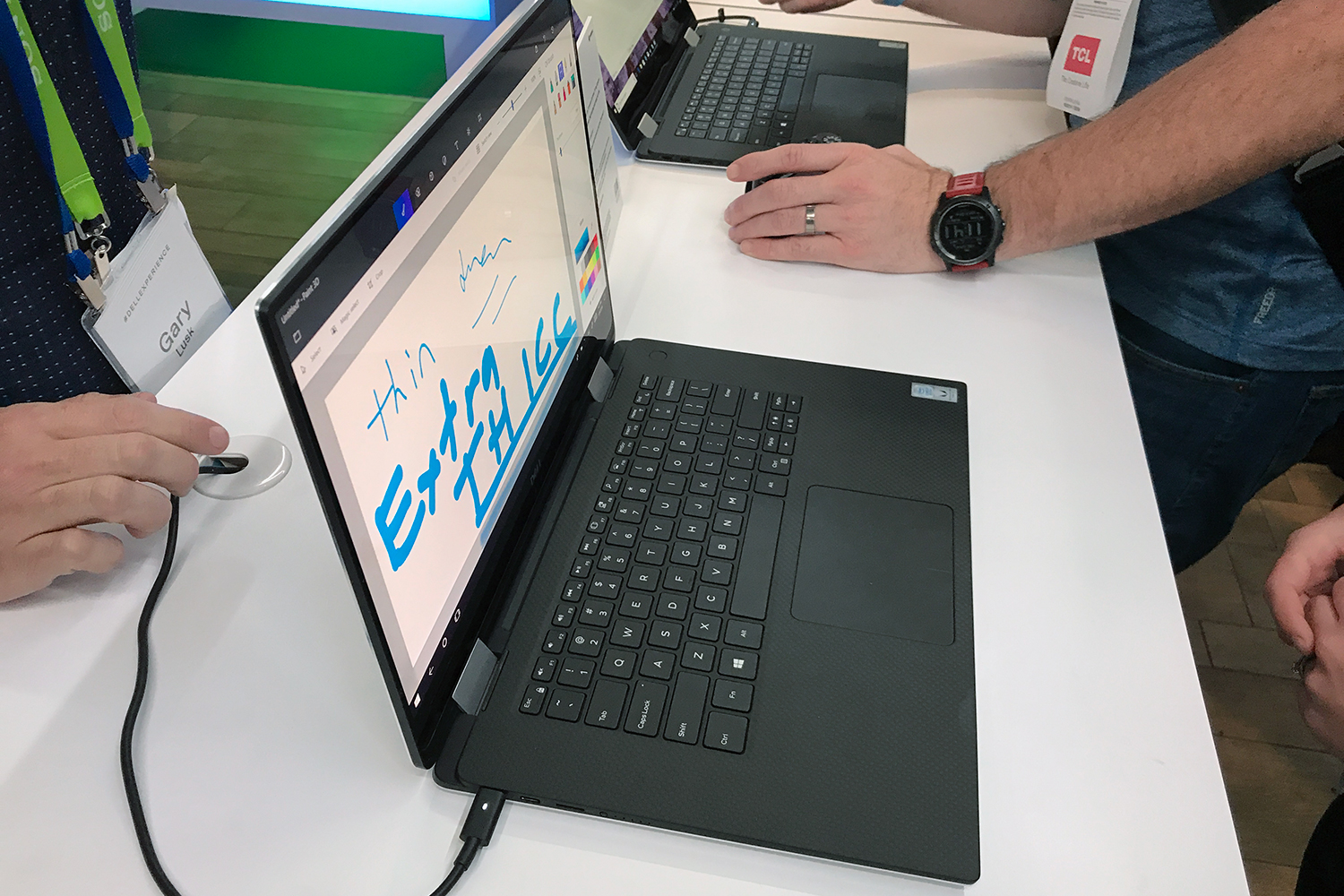
But what if we pit the Dell XPS 13 vs. Dell XPS 15 2-in-1? Dell’s larger laptop has a lot to live up to, but if anything can threaten the status of our long-time favorite notebook it’s a larger version of our favorite notebook.
Specifications
| Dell XPS 13
|
Dell XPS 15 2-in-1
|
|
| Dimensions | 11.9 x 7.8 x 0.46 inches (0.3 at thinnest) | 13.9 x 9.3 x 0.63 inches (0.35 at thinnest) |
| Weight | 2.67 pounds | 4.3 pounds |
| Processor | 8th Generation Intel Core i5, i7 | 8th Generation Intel Core i5, i7 Kaby Lake G |
| RAM | 4GB, 8GB or 16GB | 8GB or 16GB (32GB planned) |
| Graphics | Intel HD 620 | Radeon RX Vega M GL |
| Display | 13.3-inch InfinityEdge | 15.6-inch LED-backlit IPS display |
| Resolution | 1080P or 4K | 1080P or 4K |
| Storage | 256GB, 512GB, 1TB SSD (PCIe optional) | 128GB, 256GB, 512GB, 1TB PCIe SSD |
| Networking | 802.11ac, Bluetooth 4.2 | 802.11ac, Bluetooth 4.1 |
| Ports | USB-C, 2 x Thunderbolt 3, Headset, microSD | 3 x USB-C, 2 x Thunderbolt 3, 2 x USB-C 3.1, microSD, headset, Noble lock |
| Webcam | 720P webcam | 720p widescreen HD |
| Operating System | Windows 10 | Windows 10 |
| Battery | 52 watt-hours | 75 watt-hours |
| Price | $1,000+ | $1,300+ |
| Availability | Now | March 2018 |
| Review | Hands-on | Hands-on |
Design
Although both laptops in this comparison come from the same manufacturer and the same range, there are some noticeable differences in their designs that are worth considering. The overall size is most immediately obvious, with the XPS 15 2-in-1 being made in a larger form-factor and sporting a noticeable weight difference to its smaller cousin. Both are lighter than their predecessors though, partly thanks to the use of Gore fabric to maintain low weight but still dissipate heat from the new internal hardware.
The XPS 15 2-in-1 also has a slightly more traditional aesthetic to it with a black interior to its silver outer casing. In comparison, the XPS 13 has two color options: silver and “white.” Where the former offers the same silver exterior and black carbon fiber interior of the XPS 15 2-in-1, the latter utilizes fiberglass to craft a white interior that we’re told is durable and just as lightweight as the carbon fiber used in previous designs. Its outside is a more fanciful rose gold.
Looks aside though, there is one big functional difference between the two laptops and that’s their hinges. Where the Dell XPS 13 is designed to be a functional laptop with a typical laptop hinge design, the XPS 15 has a 360-degree hinge that lets it fold completely flat into tablet mode. It’s not as functional as the dynamic fulcrum seen on Microsoft’s Surface Book 2, but the XPS 15 is still the more versatile.
Both laptops have done away with USB-A ports entirely, instead opting for USB-C ports for charging, data transfer and everything else. The XPS 15 2-in-1, with its larger chassis, is able to pack in a few more ports, including a Noble lock for added security. Despite its increased size though, we weren’t hugely impressed with its maglev keyboard, preferring the more traditional design found on the XPS 13.
Considering both laptops are designed for a different purpose, your favorite design will largely rest on whether you’re looking for a convertible laptop or a lightweight notebook. While the XPS 15’s 360-hinge is a nice addition, in this case, we still feel like the expanded aesthetic options and better keyboard make the XPS 13 a better choice.
Winner: XPS 13
Hardware
When it comes to internal hardware for computers of all shapes and sizes, bigger is usually better, by virtue of having more space to pack more powerful kit inside. That’s certainly the case with the XPS 13 and XPS 15 2-in-1, even if both systems are sporting the latest offerings from their respective manufacturers.
The XPS 13 improves upon previous generations by utilizing Intel’s 8th-gen processors, with a choice of Core i5-8250U or Core i7-8550U. Those can be paired up with as much as 16GB of memory and up to a 1TB of high-speed, PCIe solid state storage (SSD). With the on board Intel HD 620 graphics, that should make it capable of all manner of mainstream computing tasks, as well as entry-level gaming and even some basic video editing if needed.
The XPS 15 2-in-1 though, is on a different level entirely — at least on paper. Although we’ll need to wait until its release in March 2018 to get a real feel for how capable it is, it comes packing one of Intel and AMD’s new combi-chip designs, codenamed Kaby Lake G. It packs up to an eighth-generation Intel Core i7 8705G processor with a graphics core from AMD’s Vega generation. It has a slightly higher turbo frequency of 4.1GHz (vs 4.0GHz) than the XPS 13 and can be paired up with up to 16GB of RAM at launch — 32GB in a post-release configuration, we’re told.
The AMD graphics chip is what could make all the difference though. The Vega M GL core is expected to be faster than an Nvidia GTX 1050 add-in graphics card. That will give the XPS 15 much more powerful 3D capabilities for gaming and video rendering. We still don’t know how impactful the on board HBM2 memory will be either.
As great as the new hardware options in the 2018 XPS 13 are, there’s no way around the fact that the XPS 15 packs a bigger punch.
Winner: XPS 15 2-in-1
Displays
Both the XPS 13 and XPS 15 have some stunning display options to choose from, as well as some more reasonable options for those looking to save a few dollars. Alongside a more traditional 1080P, Dell offers a full 4K display with its XPS 13. Both measure 13.3-inches diagonally and have full touch-functionality. Dell has dropped the non-touch option with this generation, so there are no cost savings to be made there for those who don’t need that additional input option.
The options for the Dell XPS 15 2-in-1 are much the same, with 1080P and 4K panels to choose from. The full HD resolution would be better for those looking to save on battery life or who don’t need the added detail afforded by a
Comparing the two options here is hard to do without having them side by side in our labs to put them through their paces, but with the only obvious difference being size, it’s not fair to pick one over the other just yet.
Winner: Draw
Portability

With both laptops in this comparison sporting lightweight chassis and newly trim physiques, both should be perfectly suited to computing on the go. The Dell XPS 13 has been trimmed down a few millimeters and hundredths of a pound, making it the most slimline XPS 13 to date. It’s also gone through somewhat of a weight distribution change, which makes it easier to hold and manage on the go.
The Dell XPS 15 2-in-1 is a little heavier owing to its larger display, additional ports, and heftier internal hardware, but it’s still relatively svelte for its class, weighing in at just 4.3 pounds. It’s a little thicker than the XPS 13 across all dimensions, but that’s to be expected from the larger form factor.
Beyond weight, one other important consideration for portability is battery life. Dell claims up to 19-hours battery life on the XPS 13’s 52 watt-hour unit, which is actually less than its predecessor. While we have some doubts you’ll get close to that length of time without optimum conditions, it’s still more than you’re likely to get out of the XPS 15. Although its battery is larger at 75 watt-hours, it’s only rated for 15-hours and even then only with the 1080P display.
It’s also a shame that the XPS 15’s keyboard doesn’t detach during tablet mode. As much as we like the ability to fold it flat, a 4.3-pound tablet is not as portable as some of the alternatives out there.
Winner: Dell XPS 13
Pricing and availability
There isn’t a huge difference in starting price with these two laptops. The XPS 13 begins at $1,000, while the XPS 15 2-in-1 will start at $1,300. The smaller laptop will cost you up to $2,050 in the Dell store if you opt for the top-tier version, while we don’t have final pricing for the XPS 15 just yet.
That’s a bit of a sticking point in this category too. The reason you can see all of the XPS 13’s pricing information right now, is because it’s available to buy right now. The XPS 15 on the other hand, won’t be launching until late March. Even if it ends up offering better value for money when it does debut, the fact that it’s not purchasable today means the XPS 13 takes this category. At least for now.
Winner: XPS 13
Size isn’t everything
As much as the added power of the Dell XPS 15 2-in-1 and its 360-degree hinge are nice additions, we still can’t help but give the nod to our long-time favorite, the XPS 13. It’s new 2018 model is everything we loved about its predecessors and more. With uprated hardware, a few aesthetic tweaks and continually improved weight distribution, it’s a perfectly portable computing system that’s hard to beat.
We still love the XPS 15 though. When it debuts in a few months time, it will likely find a place in our hearts too, especially for those who want a little more power under the hood.
Overall Winner: XPS 13
Editors' Recommendations
- These are the 10 best gaming PCs I’d recommend to anyone
- 9 best 2-in-1 laptops in 2024: tested and reviewed
- The 6 best 2-in-1 laptops for drawing in 2024
- Best Buy deals: Save on laptops, TVs, appliances, and more
- Here’s how two of the best Windows laptops compare to each other







